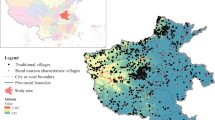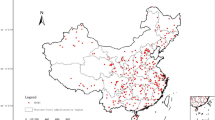Abstract
Spatial perspectives were applied to examine the processes of growth and development in rural settlements affected by tourism. Based on field surveys and GIS spatial analysis methods, we studied the spatial evolution of two villages (Jiaojiekou and Gougezhuang) in the Yesanpo tourist area over the last 25 years. The results revealed a polarization trend, with Jiaojiekou becoming a ‘hollowed’ village and Gougezhuang developing into a ‘new-type’ tourist town. This polarization indicates the unsustainability of rural development in tourist destinations, which is manifested by the following features: only some villages benefit from the development of tourism; there is simultaneously a shortage of land in tourist villages and a wastage of land in traditional villages; and the function of the villages is deficient. Nevertheless, the spillover of the effects of tourism may provide an opportunity for the development of traditional villages. To better utilize this opportunity, we propose that: (1) integrated rural tourism management should be developed to explore effective methods of promoting tourism as part of a rural development strategy; (2) different land use policies are required for different villages; and (3) the balance between government regulation and community participation should be emphasized.
Similar content being viewed by others
References
Bao JG, Su XB (2004) Studies on tourism commercialization in historic towns. Acta Geographica Sinica 59(3): 427–436. DOI: 10.3321/j.issn:0375-5444.2004.03.013 (In Chinese)
Caffyn A, Jobbins G (2003) Governance capacity and stakeholder interactions in the development and management of coastal tourism: examples from Morocco and Tunisia. Journal of Sustainable Tourism 11(2-3): 224–245. DOI: 10.1080/09669580308667204
Cai YL (2001) The mechanisms of cropland conservation in Chinese rural transformation. Scientia Geographica Sinica 21(1): 1–6. DOI: 10.3969/j.issn.1000-0690.2001.01.001 (In Chinese)
Cheng LS, Feng WY, Jiang LH (2001) The analysis of rural settlement hollowizing system of the southeast of Taiyuan Basin. Acta Geographica Sinica 56(4): 437–446. (In Chinese)
Feng WY, Chen XM (2003) Analysis on the rural settlement expansion of the Jinzhong Plain. Human Geography 18(6): 93–96. DOI: 10.3969/j.issn.1003-2398.2003.06.021 (In Chinese)
Hara Y, Takeuchi K, Okubo S (2005) Urbanization linked with past agricultural landuse patterns in the urban fringe of a deltaic Asian mega-city: a case study in Bangkok. Landscape and Urban Planning 73(1): 16–28. DOI: 10.1016/j. landurbplan.2004.07.002
Henle K, Alard D, Clitherow J, et al. (2008) Identifying and managing the conflicts between agriculture and biodiversity conservation in Europe–a review. Agriculture, Ecosystems & Environment 124(1-2): 60–71. DOI: 10.1016/j.agee.2007.09.005
Hessel R, van den Berg J, Kaboré O, et al. (2009) Linking participatory and GIS-based land use planning methods: a case study from Burkina Faso. Land Use Policy 26(4): 1162- 1172. DOI: 10.1016/j.landusepol.2009.02.008
Jenkins CL, Henry BM (1982) Government involvement in tourism in developing countries. Annals of Tourism Research 9(4): 499–521. DOI: 10.1016/0160-7383(82)90070-6
Käyhkö N, Fagerholm N, Asseid BS, et al. (2011) Dynamic land use and land cover changes and their effect on forest resources in a coastal village of Matemwe, Zanzibar, Tanzania. Land Use Policy 28(1): 26–37. DOI: 10.1016/j.landusepol. 2010.04.006
Kolahi M, Moriya K, Sakai T, et al. (2014a) Introduction of participatory conservation in Iran: case study of the rural communities’ perspectives in Khojir National Park. International Journal of Environmental Research 8(4): 913–930.
Kolahi M, Sakai T, Moriya K, et al. (2014b) From paper parks to real conservations: case study of social capital in Iran’s biodiversity conservation. International Journal of Environmental Research 8(1): 101–114.
Kolahi M, Sakai T, Moriya K, et al. (2014c) Visitors’ characteristics and attitudes towards Iran’s national parks and participatory conservation. Parks 20(1): 53–66.
Lee S-H, Choi J-Y, Yoo S-H, et al. (2013) Evaluating spatial centrality for integrated tourism management in rural areas using GIS and network analysis. Tourism Management 34: 14–24. DOI: 10.1016/j.tourman.2012.03.005
Lei ZD (2002) Rural habitat empty-disusing concept and quantitative analysis modes. Journal of Northwest University: Natural Science Edition 32(4): 421–424. DOI: 10.3321/j. issn:1000-274X.2002.04.026. (In Chinese)
Li J, Li XJ (2008) The microscopic analysis on village-hollowing in medium income and hilly land region of Henan Province. China Population, Resources and Environment 18(1): 170–175.DOI: 10.3969/j.issn.1002-2104.2008.01.033. (In Chinese)
Lin GCS (2006) Peri-urbanism in globalizing China: a study of new urbanism in Dongguan. Eurasian Geography and Economics 47(1): 28–53. DOI: 10.2747/1538-7216.47.1.28
Liu YS (2007) Rural transformation development and new countryside construction in eastern coastal area of China. Scientia Geographica Sinica 62(6): 563–570. DOI: 10.3321/j.issn:0375-5444.2007.06.001. (In Chinese)
Liu YS, Liu Y, Zhai RX (2009) Geographical Research and Optimizing Practice of Rural Hollowing in China. Acta Geographica Sinica 64(10): 1193–1202. DOI: 10.3321/j.issn: 0375-5444.2009.10.005. (In Chinese)
Liu YS, Wang JY, Long HL (2010) Analysis of arable land loss and its impact on rural sustainability in Southern Jiangsu Province of China. Journal of Environmental Management 91(3): 646–653. DOI: 10.1016/j.jenvman.2009.09.028
Long HL, Li TT (2012) Analysis of the coupling of farmland and rural housing land transition in China. Scientia Geographica Sinica 67(2): 201–210. (In Chinese)
Long HL, Heilig GK, Li X, et al. (2007) Socio-economic development and land-use change: analysis of rural housing land transition in the transect of the Yangtse River, China. Land Use Policy 24(1): 141–153. DOI: 10.1016/j.landusepol. 2005.11.003
Long HL, Li YR, Liu YS (2009a) Analysis of evolutive characteristics and their driving mechanism of hollowing villages in China. Acta Geographica Sinica 64(10): 1203–1213.DOI: 10.3321/j.issn:0375-5444.2009.10.006. (In Chinese)
Long HL, Liu YS, Wu XQ, et al. (2009b) Spatio-temporal dynamic patterns of farmland and rural settlements in Su–Xi–Chang region: implications for building a new countryside in coastal China. Land Use Policy 26(2): 322–333. DOI:10.1016/j.landusepol.2008.04.001
Long HL, Liu YS, Zou J (2009c) Assessment of rural development types and their rurality in eastern coastal China. Scientia Geographica Sinica 64(4): 426–434. DOI:10.3321/j.issn:0375-5444.2009.04.005. (In Chinese)
Long HL, Zou J, Liu YS (2009d). Differentiation of rural development driven by industrialization and urbanization in eastern coastal China. Habitat International 33(4): 454–462. DOI: 10.1016/j.habitatint.2009.03.003
Long HL, Liu YS, Li XB, et al. (2010) Building new countryside in China: a geographical perspective. Land Use Policy 27(2): 457–470. DOI: 10.1016/j.landusepol.2009.06.006
Long HL, Woods M (2011) Rural restructuring under globalization in eastern coastal China: what can be learned from Wales? Journal of Rural and Community Development 6(1): 70–94. DOI: 10.2747/0272-3638.29.4.327
Long HL, Zou J, Pykett J, et al. (2011) Analysis of rural transformation development in China since the turn of the new millennium. Applied Geography 31(3): 1094–1105. DOI:10.1016/j.apgeog.2011.02.006
Mander Ü, Jongman RHG (1998) Human impact on rural landscapes in central and northern Europe. Landscape and Urban Planning 41(3-4): 149–153. DOI: 10.1016/S0169-2046(98)00067-X
Nepal R, Thapa GB (2009) Determinants of agricultural commercialization and mechanization in the hinterland of a city in Nepal. Applied Geography 29(3): 377–389. DOI: 10.1016/j.apgeog.2008.12.002
Nepal SK (2007) Tourism and rural settlements Nepal’s Annapurna region. Annals of Tourism Research 34(4): 855–875. DOI: 10.1016/j.annals.2007.03.012
Panyik E, Costa C, Rátz T (2011) Implementing integrated rural tourism: an event-based approach. Tourism Management 32(6): 1352–1363. DOI: 10.1016/j.tourman.2011.01.009
Qian J, Feng D, Zhu H (2012) Tourism-driven urbanization in China’s small town development: a case study of Zhapo Town, 1986-2003. Habitat International 36(1): 152–160. DOI: 10.1016/j.habitatint.2011.06.012
Tong D, Feng CH, Deng JJ (2011) Spatial evolution and cause analysis of urban villages: A case study of Shenzhen Special Economic Zone. Geographical Research 30(3): 437–446. (In Chinese)
Vos W, Meekes H (1999) Trends in European cultural landscape development: perspectives for a sustainable future. Landscape and Urban Planning 46(1-3): 3–14. DOI: 10.1016/S0169-2046(99)00043-2
Wang CX, Yao SM, Chen CH (2005) Empirical study on "villagehollowing" in China. Scientia Geographica Sinica 25(3): 257–262. DOI: 10.3969/j.issn.1000-0690.2005.03.001 (In Chinese)
Wang YM, Scott S (2008) Illegal farmland conversion in China’s urban periphery: local regime and national transitions. Urban Geography 29(4): 327–347. DOI: 10.2747/0272-3638.29.4.327
Wei YP, Zhao M (2009) Urban spill over vs. local urban sprawl: entangling land-use regulations in the urban growth of China’s megacities. Land Use Policy 26(4): 1031–1045. DOI: 10.1016/j.landusepol.2008.12.005
Xi JC, Zhao MF, Ge QS (2011) The micro-scale analysis of rural settlement land use pattern: a case study of Gouge village of Yesanpo scenic area in Hebei province. Acta Geographica Sinica 66(12): 1707–1717. (In Chinese)
Xing GR, Xu YL, Zheng Y (2007) Rural settlement spatial evolution types and features in the process of urbanization. Economic Geography 27(6): 932–935. DOI: 10.3969/j.issn. 1000-8462.2007.06.013 (In Chinese)
Xue L (2001) Study on the inner decaying village and the countermeasures with Jiangsu province as the case. City Planning Review 25(6): 8–13. DOI: 10.3321/j.issn:1002-1329.2001.06.002 (In Chinese)
Yu XJ, Ng CN (2007) Spatial and temporal dynamics of urban sprawl along two urban–rural transects: a case study of Guangzhou, China. Landscape and Urban Planning 79(1): 96–109. DOI: 10.1016/j.landurbplan.2006.03.008
Zhu HY, Li XB, He SJ, et al. (2001) Spatio-temporal change of land use in Bohai Rim. Acta Geographica Sinica 56(3): 253–260. DOI: 10.3321/j.issn:0375-5444.2001.03.001 (In Chinese)
Zou DC (1994) Floor area ratio. Urban Planning 1:19-23. (In Chinese)
Author information
Authors and Affiliations
Corresponding author
Additional information
http://orcid.org/0000-0001-9366-8867
http://orcid.org/0000-0002-4593-3643
http://orcid.org/0000-0003-2036-0153
Rights and permissions
About this article
Cite this article
Xi, Jc., Kong, Qq. & Wang, Xg. Spatial polarization of villages in tourist destinations: A case study from Yesanpo, China. J. Mt. Sci. 12, 1038–1050 (2015). https://doi.org/10.1007/s11629-014-3358-9
Received:
Accepted:
Published:
Issue Date:
DOI: https://doi.org/10.1007/s11629-014-3358-9




